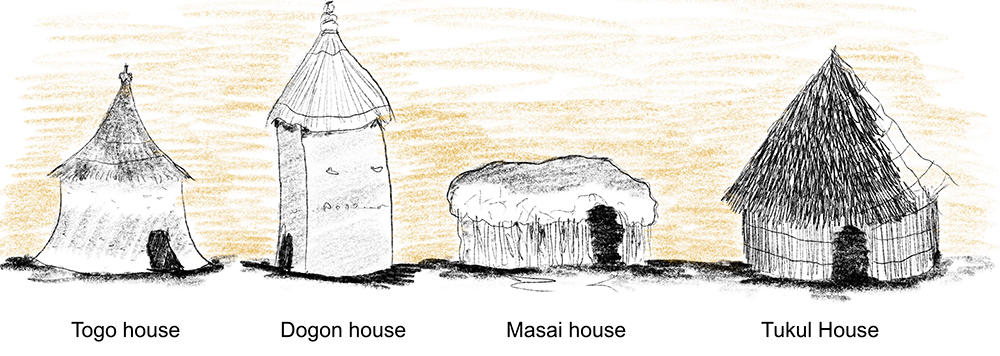A history of timber framing
[edit] Light roundwood skeletal
The oldest form of timber construction is what one might call a frame construction which is made using young growth round wood poles, here we call this round wood skeletal. Some of the earliest forms of basic shelter would have been made from natural found materials such as reeds, leaves, grass or bark laid over a simple frame of full branches that did not need cutting or slicing. Whilst early humans may have been nomadic, the frames could have been clad with animal skins and bound with natural reeds, often triangular and easy to erect and disassemble, commonly referred to as an early form of yurt.
The first recordings of a yurt were made by Herodotus of Halicarnassus who described yurt-like tents as the dwelling place of the Scythians, a horse riding-nomadic nation who lived in the northern Black Sea and Central Asian region from around 600 BC. Simple braced frames structures or reed hut shelters can still be found today in places like Sudan and Iraq, whilst yurts can be seen in Central Asia.
In places like the Cones of Cappadocia dwellings were constructed directly from soft volcanic stone without the use of timber. Other dwellings such as those found in Togo and Timbuktu were built with solid earth wall bases and thin wood and straw roofs. Hybrid structures using a timber skeleton as the primary base of the walls, plastered with wet earth and clay, might be seen in the Masai tribes in East Africa.
In Ethiopia, in the late 1800’s as timber stocks around Addis Ababa ran bare due to use as building material and fuel for a growing population, the king at the time planted Blue Eucalyptus due to its ability to grow quickly and ot regrow from stumps (early coppice wood). The Tukul or Sarbet grass house thus became a common round wood skeletal form of shelter, made with coppice round wood, wiht a triangular roof sitting on a circular structure of timber and reed that was then plastered in clay and earth. Many other examples of these simple timber round wood structures forming the basis of shelter, tents, and hybrid earth structures exist around the world. Examples can be found in the excellent pictorial essay book 'Shelter', first published in 1973 by shelter publications.
[edit] Roundwood base frame
Whilst this section relates very much to the previous, it differs in that this describes a time when people started to use larger sections of timber to create what might be described more as a frame rather than a skeleton structure. Initially also primarily using round wood but with larger sections, these frames were more rigid and stable on their own rather than in combination with the cladding of earth and other materials.
The earlier type of Anglo Saxon shelter (450-1066) would have been a very simple rectangular shape, single story with a pitched roof and no walls.
[edit] Log construction
[edit] Stilt construction
[edit] Post and beam
[edit] Cruck frame
[edit] Green wood framing
[edit] European Oak framing
[edit] Balloon frame
[edit] Platform frame
[edit] Insulated log wood
[edit] Unitised timber frame
[edit] Engineered wood frames
[edit] Modular systems
[edit] Massive wood monolith
[edit] Gridshells
Featured articles and news
One of the most impressive Victorian architects. Book review.
RTPI leader to become new CIOB Chief Executive Officer
Dr Victoria Hills MRTPI, FICE to take over after Caroline Gumble’s departure.
Social and affordable housing, a long term plan for delivery
The “Delivering a Decade of Renewal for Social and Affordable Housing” strategy sets out future path.
A change to adoptive architecture
Effects of global weather warming on architectural detailing, material choice and human interaction.
The proposed publicly owned and backed subsidiary of Homes England, to facilitate new homes.
How big is the problem and what can we do to mitigate the effects?
Overheating guidance and tools for building designers
A number of cool guides to help with the heat.
The UK's Modern Industrial Strategy: A 10 year plan
Previous consultation criticism, current key elements and general support with some persisting reservations.
Building Safety Regulator reforms
New roles, new staff and a new fast track service pave the way for a single construction regulator.
Architectural Technologist CPDs and Communications
CIAT CPD… and how you can do it!
Cooling centres and cool spaces
Managing extreme heat in cities by directing the public to places for heat stress relief and water sources.
Winter gardens: A brief history and warm variations
Extending the season with glass in different forms and terms.
Restoring Great Yarmouth's Winter Gardens
Transforming one of the least sustainable constructions imaginable.
Construction Skills Mission Board launch sector drive
Newly formed government and industry collaboration set strategy for recruiting an additional 100,000 construction workers a year.
New Architects Code comes into effect in September 2025
ARB Architects Code of Conduct and Practice available with ongoing consultation regarding guidance.
Welsh Skills Body (Medr) launches ambitious plan
The new skills body brings together funding and regulation of tertiary education and research for the devolved nation.
Paul Gandy FCIOB announced as next CIOB President
Former Tilbury Douglas CEO takes helm.
























